Abstract
Raw earth has useful applications in contemporary buildings as a sustainable and circular construction material. The present study aims to assess the environmental performance of several earth-based wall systems with similar thermal performance, through a life cycle thinking approach. In particular, a life cycle assessment is developed for (a) unstabilized rammed earth (produced in situ), (b) compressed earth blocks (prefabricated in the factory), (c) stabilized rammed earth and (d) light earth, all combined with biobased (natural fibers, e.g., lime hemp, cork) and/or conventional materials for building insulation. Results show benefits in terms of avoided carbon emission, water footprint and embodied energy throughout the production chain and highlight limits and potential improvements. In addition, the CO2 offset by crops is also estimated based on carbon embedded in natural fibers. In particular, light earth wall systems are the most suitable to minimize environmental impacts, while massive constructive technologies (as unstabilized rammed earth) show a higher dynamic thermal performance for intended use in Mediterranean climates.
1. Introduction
Earthen construction is one of the oldest known building practices []: indeed, it has been used as a traditional construction technology in many countries around the world, and nowadays it is regaining momentum as a contemporary green building technique [,,,].
Although most earthen constructions are present in the least-developed countries, their use is also becoming established in industrialized ones due to growing environmental awareness []. Many authors have pointed out the barriers to the development of earth-based technologies []. Nevertheless, their potential in the construction market cannot be ignored, especially if we rethink production within a circular approach or consider the issues related to the 18 Nature’s Contributions to People and the 17 SDGs of the UN Agenda 2030 [,].
The numerous advantages of raw earth as a building material are nowadays universally recognized [,,] and cover diversified sectors: low energy consumption [,], excellent indoor air quality [,], hygrothermal comfort [,,,,,,,], lack of volatile organic compounds (VOCs) [,], recyclability [] and reduction of CO2 production []. Moreover, non-toxicity, local availability and the possibility of using soils from footing excavation with very low initial costs are also acknowledged in raw earth construction []. Furthermore, clay-based materials have been shown to act effectively as passive removal materials (PRMs) for ozone [].
If, as mentioned, raw earth can be used as a sustainable and circular construction material for contemporary buildings [,,,,], it is beneficial to quantify environmental impacts in order to compare its performance with other materials and building systems. This is why numerous life cycle assessments (LCAs) of raw earth construction techniques or products have been carried out in recent years.
Several studies evaluate the environmental impacts of a single construction technique (even with different stratigraphy variants). Shukla et al. [] calculated embodied energy of an adobe house. Reddy and Kumar [] focused on the embodied energy of concrete-stabilized rammed earth (CSRE) walls. Melià et al. [] compared the environmental impacts of earthen plasters with conventional ones using chemical binders (as cement or hydraulic lime). Suprahman et al. [] analyzed embodied energy in rammed earth applications: in particular, they used the LCA inventory data method based on the analysis of a rammed earth wall prototype. Serrano et al. [] compared three types of stabilized rammed earth technologies: rammed earth stabilized with straw and slacked lime; rammed earth stabilized with straw and alabaster powder; rammed earth stabilized with pneumatic fibers and lime. Arrigoni et al. [] compared cement-stabilized rammed earth mixtures with mixtures involving the use of recycled concrete aggregates, an inert material derived from concrete structure demolition. Christoforou et al. [] focused on adobe production (from cradle to site), examining different production scenarios: adobe produced on-site with locally available soil and delivered straw or sawdust, adobe produced on-site with transported soil and straw/sawdust and adobe manufactured in factories. Nanz et al. [] analyzed the impacts of production, construction and transportation phases on the embodied energy of rammed earth façades. In particular, four different variants of RE were compared: the first consisted of prefabricated rammed earth units with geo-grid and trass mortar, the second was made of earth bricks and plaster, the third was a cavity rammed earth wall with interposed foam glass insulation and the fourth was made of earth brick, EPS insulation and plaster.
Other studies compare different earth-based construction solutions in terms of environmental impacts. For this comparison, a useful starting point is provided by Arduin et al. []: this research produced a systematic literature review to verify LCA methodology trends for several earth-based construction techniques and products. In particular, adobe, cob, rammed earth (RE), compressed earth block (CEB) and light straw clay (LSC) techniques were studied.
In a comparison between rammed earth and compressed earth blocks, Narayanaswamy et al. [] concluded that the two solutions have similar GWP.
Ben-Alon et al. [] provided a comparison in terms of LCA between natural earth materials and conventional building materials in six climates: hot desert, desert, semi-arid, Mediterranean, temperate and continental. More precisely, this investigation focused on four natural wall assemblies (cob, light straw clay and insulated and uninsulated rammed earth) and three conventional assemblies (light timber frame, insulated and uninsulated concrete masonry).
Meek et al. [] explored the cradle-to-gate greenhouse gas emissions of rammed earth materials incorporating recycled waste, industrial by-products and either NaOH or hydrated lime. The recycled waste included crushed bricks and concrete, while the industrial by-products were ground granulated blast furnace slag, fly ash and silica fume. These materials are then compared to those used in conventional construction in Australia (cavity brick and brick veneer walls).
Finally, a study carried out by Fernandes et al. [], further focuses on the environmental performance of raw earth materials. The authors present a life cycle assessment of compressed earth blocks (CEB) and rammed earth walls. The benefits of adopting these techniques were discussed for the different life-cycle stages, including the possibility to recycle earthen materials at their end-of life in a closed-loop approach.
Therefore, in recent years, numerous studies have been developed, aimed at verifying the true sustainability of earth-based technologies, but the methodologies and the standards adopted are not always the same. Moreover, even if the adopted methodologies are the same, the production chains and the energy mix used in different nations can be difficult to compare. Furthermore, many studies refer to a functional unit equal to 1 m3 without considering the real stratigraphies adopted (depending on geographical area or climatic conditions). This is why comparisons between different LCAs cannot always be performed.
These are the reasons why, in this contribution, we correlate the environmental performance of eight types of earth-based walls, belonging to three different construction technologies (i.e., rammed earth, compressed earth blocks and light earth), with similar thermal performance. Compared to previous investigations, this analysis focuses on the possible use of biobased thermal insulation to improve thermal performance of earth-based walls and quantify their environmental impacts. Material properties used for the estimation of the thermal performances of the walls are taken from the literature or assessed by the authors (as happens for the modular biobased reinforced rammed earth wall solution). Moreover, the eight construction solutions are compared with a mainstream building technique (clay block walls) that is conventionally used in Italy. For all the investigated wall solutions, a functional unit of 1 m2 of wall is used, comprising the stratigraphy description and thicknesses that comply with Italian energy standards. Outcomes show environmental performances of these technologies to inform practitioners in the architecture, engineering and construction sectors. The standard LCA methodology used allows for comparison of different construction systems on a quantitative basis.
2. Materials and Methods
The study focuses on the comparison of eight different contemporary earthen construction technologies for walls with a conventional wall construction system. Wall assemblies have been chosen from those that are in use in contemporary earthen architecture. For each of these assemblies, the main thermal parameters have been estimated, including static parameters, such as thermal transmittance, and dynamic parameters, such as time lag and decrement factor, based on material properties assessed in previous contributions of the authors [,] and values from the literature [,].
The wall assemblies under study are unstabilized rammed earth (RE), a modular biobased reinforced rammed earth (mRE), core-insulated cement-stabilized rammed earth (sRE), light earth (LE) and unstabilized compressed earth blocks (CEB). A porotherm clay block wall (Benchmark), with interior and exterior cement plaster, has been used as the benchmark since it represents one of the most common wall types for new residential buildings in Italy.
It is essential to briefly discuss the limitations of this research. In this investigation, massive earthen walls were combined with biobased thermal insulation (such as hemp lime and cork panels) in order to reach homogeneous thermal performances, which comply with Italian energy regulations []. In particular, the whole analysis refers to the city of Catania (climatic zone B, per Italian energy regulations). Concerning the methodology adopted for the LCA (detailed in Section 2.3), the production processes and the distances counted for the transport phase reflect the aim of containing environmental impacts through the choice of materials quarried and/or produced nearby. Furthermore, it is important to remark that, for the LCA, only the materials used for the envelope solutions have been considered in the calculation, omitting the contribution of additional stiffening framing structures, which should be used in seismic areas such as the city of Catania.
2.1. Wall Technologies
This paragraph explains the conventional and the earth-based wall systems (Figure 1) that have been compared in terms of thermal and environmental performances.
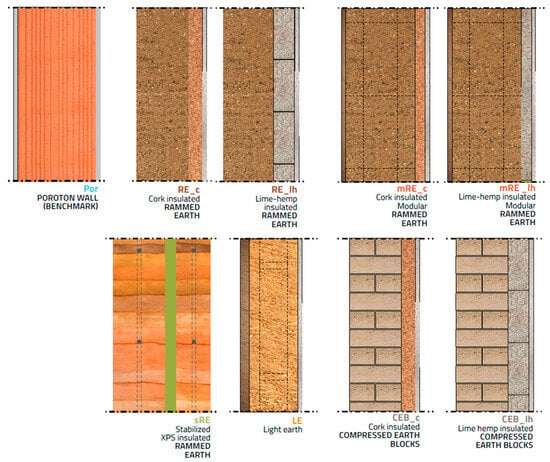
Figure 1.
The analyzed earth wall systems.
2.1.1. Clay Block Wall (Benchmark)
The Porotherm clay block is the most famous clay block for construction. Its introduction into the building market was the innovation that permanently changed the use of brick in contemporary construction. Porotherm vertical envelopes are the most-used in Italian building stock. In recent years, further steps have been taken to increase the performance of this material, for instance, the insertion of insulation inside special holes in the Porotherm blocks to avoid the use of panels or insulating mats.
The vertical closure analyzed herein uses 45 cm-thick clay blocks and two layers of lime plaster on the exterior and the interior side of the wall.
2.1.2. Unstabilized Rammed Earth (RE)
Rammed earth is a technique that is believed to have been imported from the neighboring Maghreb and to have spread from there to Europe through the Arab conquest of the Iberian Peninsula in medieval times []. From Spain, the technique spread to other major European nations, especially France and northern Italy [].
In general, traditional European and North African rammed earth construction uses coarse-grained inorganic soils, i.e., with a high percentage of sand, gravel and pebbles, held together by a clay matrix that rarely exceeds 10 to 15% of the total content.
Moistened, possibly additive-stabilized soil masses (optimized in relation to their mechanical strength and water absorption) are cast inside formwork in layers between 10 and 20 cm high and then compacted, using manual or pneumatic tampers. Usually, such layers, when compacted, take on characteristic total heights between 7 and 10 cm. Once a layer is completed, subsequent ones are added and compacted until the formwork is complete. The formwork, traditionally made of wood but now made of aluminum and plastic panels, is equipped with external reinforcements and tie rods that, through the installation of side rails, allow the definition of a complete masonry panel. The construction of a traditional rammed earth wall is carried out by proceeding horizontally around the entire perimeter of the building to be constructed. Once the masonry ring is completed, the formwork is lifted and the next layer is built, taking care to offset vertical joints of successive rings by at least half a module (i.e., half of a formwork). In this way, the joints between one horizontal layer and another do not coincide, which allow for an improvement in the monolithic behavior of the wall. Today, construction by continuous vertical septa is preferred, using formworks based on concrete technology, especially when other reinforcing elements (ring beams, surface reinforcement systems) are juxtaposed.
The vertical closure analyzed herein is composed of a 30 cm-thick layer of unstabilized rammed earth (including natural local soil and local volcanic sand) and an exterior layer of biobased thermal insulation. The rammed earth walls are designed to be built in situ by using a soil mix which was presented elsewhere (the URE mixture described in []), composed by a Sicilian soil blended with a volcanic sand quarried in the nearby Mount Etna.
In this work, two types of thermal insulation have been chosen, with the aim of enhancing the thermal resistance of the uninsulated rammed earth wall: a 12 cm-thick lime hemp block (composed by lime and hemp shivs, this solution being named RE_lh) and an 8 cm-thick cork panel (RE_c). The difference in thickness is due to the higher thermal performance of cork panel compared to the adopted lime hemp block.
2.1.3. Modular Biobased Reinforced Rammed Earth (mRE)
The modular biobased reinforced rammed earth is a patented construction technology that was exposed in a previous contribution []. This technology uses 40 cm-thick load-bearing rammed earth walls, designed to have high seismic resistance and improved thermal performance in hot and temperate climates. The rammed earth walls use a soil mix presented elsewhere (the FSRE mixture described in []), incorporating a Sicilian soil blended with a volcanic sand, quarried in the nearby Mount Etna, and a natural fiber. The major innovation of mRE technology is the reinforcement system, composed of vertical and horizontal elements in timber and nylon/polyester ropes. These elements have a dual function: they integrate the formwork system during the construction process and they serve as built-in seismic resistant devices embedded in the structure. In particular, the timber reinforcements provide an over-resistance to the wall, increasing its bending and shear resistance. At the same time, the rope surface reinforcement is coupled to the timber skeleton and tensioned to confine the wall, preventing out-of-plane collapse mechanisms. The nylon ropes are protected from atmospheric degradation and ultraviolet radiation by a finishing layer of earth-based or lime-based fibrous body plaster.
In this analysis, mRE walls are insulated from the outside by two types of thermal insulation: a 10 cm-thick lime hemp block (this solution being named mRE_lh) and a 6 cm-thick cork panel (mRE_c). The difference in thickness is due to the higher thermal performance of cork panel compared to the adopted lime hemp block.
2.1.4. Core-Insulated Cement-Stabilized Rammed Earth (sRE)
Core-insulated cement-stabilized rammed earth is a construction technology for rammed earth structural walls used in several nations like Canada, United States and Australia []. This construction technology involves the use of two layers of cement-stabilized rammed earth walls [] reinforced with steel rods, between which are inserted a layer of synthetic insulation like PU, XPS or EPS.
This construction system uses a specific formwork to build rammed earth walls: the formwork is a modular system composed of several terminal panels, which can be combined in various configurations, to allow the construction of rammed earth walls of variable lengths. A patented system [] based on rammed earth core-insulated technology uses formwork panels that can easily be assembled and disassembled to be able to support the side panels without the need for through-ties; moreover, these formwork panels are interchangeable and can be used to create different wall configurations. The wall, when complete, has two external loadbearing rammed earth walls and an insulating core [], which allow for the achievement of high thermal performance, especially for more cold and continental climates.
In this analysis, the interior rammed earth wall is 30 cm thick and the interior one is 20 cm thick. The interposed wall insulation is a 6 cm-thick XPS insulation. As the soil for rammed earth is cement-stabilized, there is no need to juxtapose an exterior plaster to protect the wall.
2.1.5. Light Earth (LE)
This technique represents an evolution of the historical wattle and daub technique. Compared to wattle and daub [], where the soil mixture is applied on a grid support structure, the lightened soil of light earth (LE) technique can be installed by means of formwork and, by doing so, it can reach greater thicknesses. This technique was rediscovered and optimized in more recent years by the German architect Franz Volhard [].
The basic material for this technique is a mixture of liquid earth mixture (earth slip) and lightweight aggregates, which have the task of reducing the mass of the wall, increasing its thermal insulation characteristics; these can be either natural fibers (such as hay straw, rice straw and hemp) or lightweight mineral aggregates (such as pumice, expanded clay and perlite). For the preparation of the material, the lightweight aggregates are mixed with the earth slip in large tanks; once this is complete, the material is left to rest for a period of at least 24 h to sufficiently hydrate the clays within the soil. According to Volhard, with the purpose of having good cohesion characteristics, the soil used must have a clay content between 12% and 20%. In order not to compromise the workability of the mixture, it is advantageous to use natural fibers with a length of less than 10 cm [].
The improved construction technique designed by Volhard uses pairs of posts on the two outer sides of the wall; every two pairs of posts, wooden boards are screwed to them. These boards act as formwork for the compaction of the lightened soil mixtures; compaction is usually carried out using hand pestles. Once the wall segment is completed, formworks can be dismantled after approximately 24 h, while its drying process will be longer. In terms of finishing, the wall can be either plastered or paneled. It is worth mentioning the possibility, adopted especially in recent years, of prefabricating lightened earth building blocks and panels to be combined with load-bearing timber frames.
In this investigation, the light earth wall is 28 cm thick, with an exterior lime plaster and an interior raw earth render.
2.1.6. Unstabilized Compressed Earth Blocks (CEB)
Compressed earth blocks are usually made from a damp mix of raw earth, sand and, eventually, a stabilizer (such as cement or lime), poured into a steel press and then compressed either with a mechanical or a pneumatic press. The compaction of the earth mass allows for the increase in the block’s density and, consequently, the improvement in the block’s mechanical performance. Once the block is shaped, it is left to dry for a month or more (if a stabilizer like lime is used) and then it is ready to be used as an element for masonry as a conventional fired brick. Compressed earth blocks can be used in simple, double and more complex walls, such as, for instance, cavity walls or insulated walls. Several companies that produce CEBs provide construction guidelines to help builders and practitioners in the production and construction phases.
In this work, a 30 cm-thick CEB wall is proposed; in order to improve its thermal insulation, it is coupled with an exterior layer of 8 cm-thick cork insulation (CEB_c) or with 12 cm-thick lime hemp insulation (CEB_lh).
2.2. Thermal Performance Assessment at Wall Scale
The following paragraph details the main thermal properties of the materials which compose the nine analyzed wall technologies. Data concerning conventional building materials, such as lime and lime cement plasters, Porotherm blocks and XPS panels, were taken from the Italian standard UNI 10351:2021 []. Lime hemp thermal and physical values were taken from [,] and cork ones were taken from []. Unstabilized rammed earth and fiber-reinforced rammed earth thermal and physical values refer to a previous work from the authors, i.e., to the URE and to the FSRE mixes described in []. For light earth density, thermal conductivity and specific heat capacity values were derived from []. For cement-stabilized rammed earth, values were taken from [], while compressed earth blocks values were taken from a technical data sheet []. Constructions and material properties are detailed in Table 1.

Table 1.
Construction layers and thermal properties of analyzed wall assemblies.
The assessment of thermal performance of the nine construction materials was carried out based on both steady-state parameters, such as U-value [] and Surface Mass, and dynamic thermal parameters, such as periodic thermal transmittance, Time Lag and Decrement Factor []. The thickness and composition of the walls was designed to fall within the requirements of the Italian Minister Decree 25/06/2015 [] for the defined climatic zone.
Document [] transposes the main principles of the 2010/31/UE for the calculation of primary energy and the evaluation of energy efficiency of buildings. In particular, the abovementioned Decree 26/06/2015 defines the limit values of thermal transmittance for building envelope components in new and existing buildings. The definition of a limit thermal transmittance limits heat dispersions through envelope elements. In this investigation, the climatic zone B, corresponding to a Mediterranean climate with Heating Degree Days (HDD) between 600–900, has been chosen. The limit U-value to be adopted is, therefore, 0.43 W/m2K.
2.3. Life Cycle Assessment Methodology
The LCA was developed in compliance with ISO 14040 (International Standard Organization, 2006) [] and 14044 (International Standard Organization, 2020) [].
The system boundaries encompass the main processes of the walls’ life cycle, from cradle to grave. The analysis examines impacts of the main material and energy inputs throughout four life cycle phases, including (i) upstream: production of materials and building elements from the extraction of raw materials, including operations to extract and process soil; (ii) core: production of walls in two alternative ways, by assembling elements produced in the factory, such as blocks, or on site, such as rammed earth and light earth; (iii) maintenance: material replacement based on estimated lifetime; (iv) end-of-life treatment: considering disassembling, transport and disposal or treatment of waste materials. The flow chart in Figure 2 shows the sequence of life cycle processes in detail, with inputs to phases and outputs, i.e., emissions to air, water and soil.
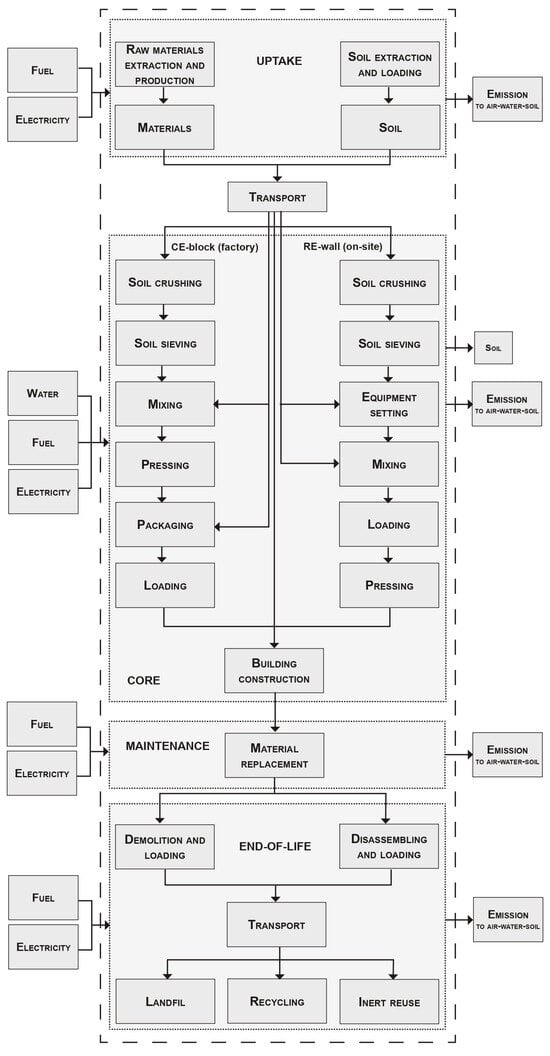
Figure 2.
Flow chart of the LCA.
The functional unit (FU) is 1 m2 of wall, assuming a similar energy performance for each analyzed wall, showing variable thicknesses. A 100-year comprehensive lifetime of walls has been assumed (this allows for estimating the impact of maintenance as periodic replacement of parts subject to wearing over time).
The inventory data were collected by considering volumes and mass of materials used per each wall, based on thickness and specific weight (uptake). Emissions from trucks carrying materials and construction components were calculated depending on material origin and treatment. A distance of 100 km has been assumed for sand, fibers, insulation, cladding materials and products. Raw earth is assumed to be extracted within a radius of 30 km, in order to restrain the impacts due to transport phase.
For assembly and installation, the consumption of materials and energy (electricity and diesel) for raw earth processing has been estimated with regard to standard operations (e.g., soil crushing, sieving, mixing, pressing and drying, packaging, loading) made by standard machineries (e.g., backhoe loader, hammer-mill soil crusher, mixer, hydraulic press, skid-steer loader, telescopic handler). These processes correspond to the core phase.
For maintenance, material replacement has been predicted based on the estimated lifetime, e.g., materials with 20-year lifetime are replaced four times in a 100-year life span (assumed in the FU).
For decommissioning and end-of-life, recycling and landfill disposal were postulated, depending on the nature of materials, e.g., stabilized earth is not recyclable. Regarding recyclable materials, the emissions for their transport to a hypothetical waste management center (50 km by truck) were counted. Raw earth was deemed to be disposable on site whenever not stabilized with chemicals (that is to say, for all the examined systems except the sRE solution, which uses cement in the raw earth mixture).
The inventory data related to the life cycle’s components and processes can be found in Table 2. The processing of the Life Cycle Impact Assessment and the modeling of the inventory were performed in SimaPro 9.3 software. In addition, Ecoinvent v3.6 database was used as secondary source of data. With a 100-year time horizon, the impact category Global Warming Potential—GWP100a—was assessed using the CML-IA approach, the Water Footprint was evaluated using the AWARE method, and the Embodied Energy was assessed using the CED method.

Table 2.
Life cycle inventory.
3. Results
As highlighted in Section 2, all the raw earth wall systems studied in this work are designed to meet the energy standard of the Italian Minister Decree 25/06/2015. A limit thermal transmittance value of U = 0.43 W/m2K and a minimal surface mass value of 230 kg/m2 were used for the design of the wall construction. During the design phase of the earth wall systems, effort was put into choosing standard thicknesses of raw earth products and thermal insulation panels used in the construction market; the result of this choice implied that not all the defined wall assemblies had the same thermal transmittance, but all complied with the limit U-value.
Table 3 shows the calculated values of the periodic thermal transmittance Yie, decrement factor DF and time lag TL. As explained in a previous contribution [], Yie and DF values below 0.10 are needed to have optimal dynamic thermal behavior, especially in hot temperate climates, such as the one analyzed herein, where an important dampening effect of the thermal wave must be performed by the wall envelope. Similarly, TL values above 8 h are a good measure of the capacity of the wall to efficiently shift the thermal wave.

Table 3.
Thermal performance of earth wall systems.
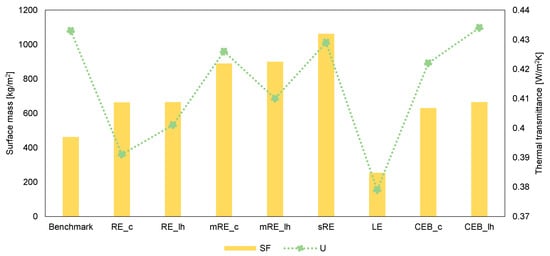
Figure 3.
Thermal transmittance and surface mass of the investigated raw earth wall systems.
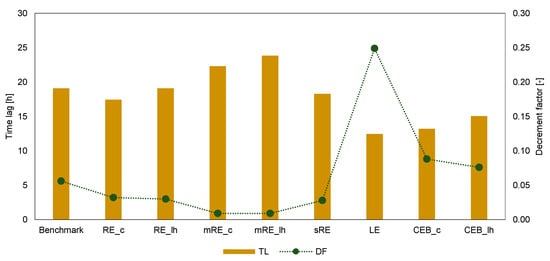
Figure 4.
Time lag and decrement factor of the investigated raw earth wall systems.
For TL and SM categories, the best performance is obtained for the solution with the highest values of time lag and surface mass. The sRE solution is the one with the highest surface mass (1062 kg/m2), given the outdoor exposed rammed earth layer, but its TL value is not the best one. The mRE solutions also have good performances: in particular, mRE_c has a TL of 22.31 h and an SM of 889 kg/m2, while mRE_lh has a TL of 23.84 h and an SM of 900 kg/m2. On the other side, the LE solution has the worst performance, as it is the one that provides the lowest time lag (12.45 h) and the lowest surface mass value (254 kg/m2). The other raw earth wall solutions have intermediate and rather good performances compared to the benchmark solution because of their high thermal mass.
For DF, Yie and U categories, the best performance is found for the solutions that minimize these properties. LE is the best solution for U-value because it has the lowest thermal transmittance (0.379 W/m2K), due to the low thermal conductivity of the light earth layer; even so, it has the worst DF and Yie, as these values are the highest between all the analyzed ones (respectively, 0.249 and 0.094 W/m2K).
On the contrary, mRE solutions have the best DF and Yie values, as the decrement factor and the periodic thermal transmittance of these solutions are the lowest among all the investigated solutions (respectively, 0.009 and 0.004). Nevertheless, their thermal transmittances are not the lowest one, even if they still respect the energy standard limitations. The other raw earth wall solutions have intermediate and rather good performances compared to the benchmark solution.
The following table (Table 4) reports the results of the LCA of the analyzed wall systems. Please note that the natural fiber considered for the mRE solutions is straw. Compared to the benchmark wall (Porotherm clay block solution), whose environmental performance was taken from [], all the examined earth wall systems (excluding the sRE solution) have lower carbon footprint values. Similarly, earth wall systems have lower water footprint and embodied energy values. The embodied energy value for the sRE solution is remarkably low, a fact which could be explained by the fact that, for this solution, the cladding layer is not used, as it is the exterior rammed earth layer exposed to the outdoor climates.

Table 4.
Environmental performance of benchmark and raw earth wall systems.
In general, the carbon storage is higher for the earth wall solutions using natural fibers and biobased insulations, and, in particular, the highest is found for the mRE solutions, which use a fiber in a raw earth mixture, a wood reinforcing system and two biobased thermal insulations (cork panels and lime hemp blocks). The solution with the third-highest carbon storage is LE because it uses the highest amount of fibers in the raw earth mixture.
The environmental impacts are plotted in the comparative graph in Figure 5.
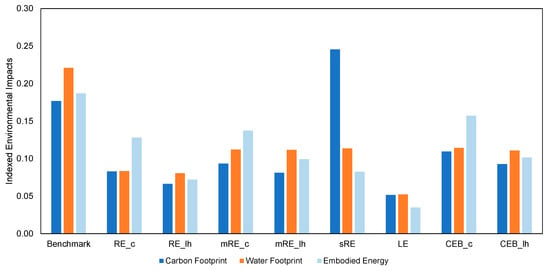
Figure 5.
Indexed environmental performances of the investigated raw earth wall systems compared to the benchmark wall.
4. Discussion
Figure 6 shows three radar graphs, where a comparison of the different thermal and environmental performances of the studied earth wall systems is presented. In particular, thermal performances include surface mass (SF), thermal transmittance (U), thermal periodic transmittance (Yie), decrement factor (DF) and time lag (TL). Environmental performances include carbon footprint (CF), water footprint (WF), embodied energy (EE) and carbon storage (CS). A normalization criterion is applied to the following graph: the values have been normalized to the best performances, so that a value near the center of the graph is a worse performance compared to a value near the vertexes of the graph, representing the best performance. Results are separated for each different family of raw earth techniques: rammed earth techniques, light earth techniques and compressed earth block techniques. In each of the three graphs, the performance of the benchmark technique (Porotherm clay block) is reported for comparison.
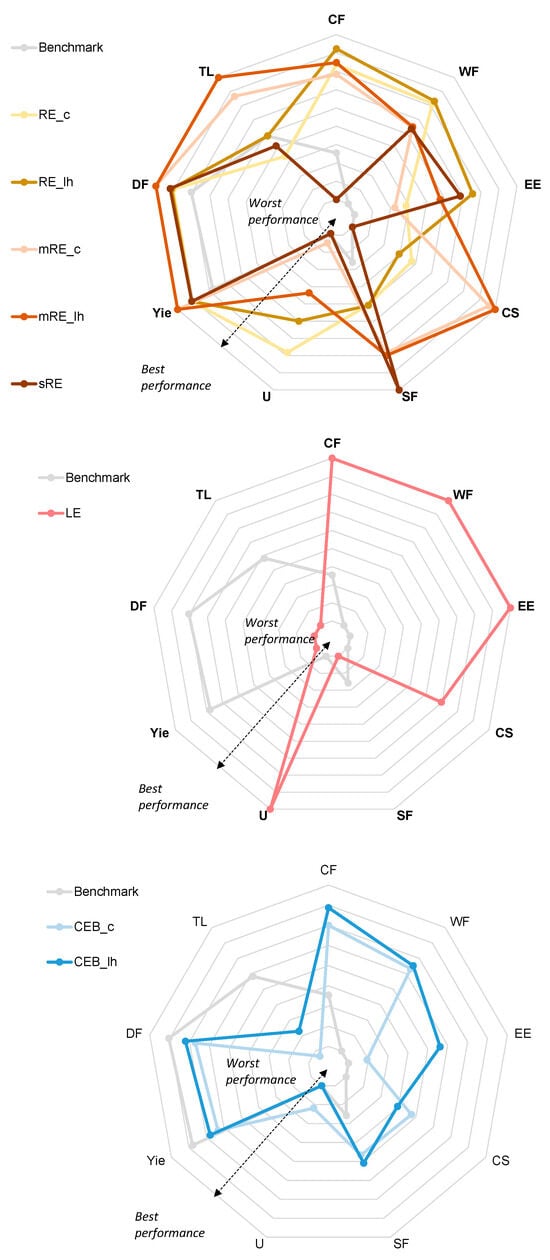
Figure 6.
Radar graphs showing performance comparison between the three different families of raw earth techniques.
Furthermore, Figure 7, Figure 8 and Figure 9 present several diagrams concerning the contribution to the three environmental impacts (carbon footprint, water footprint and embodied energy) of the various inputs described in the life cycle inventory of the analyzed raw earth wall systems. These inputs are earth mixture, insulation and claddings, traveled distance, production in factory, construction on site, maintenance and end of life treatment. The following discussion in the paper analyzes the influence of these inputs on the thermal and environmental performances of the different earth wall systems.
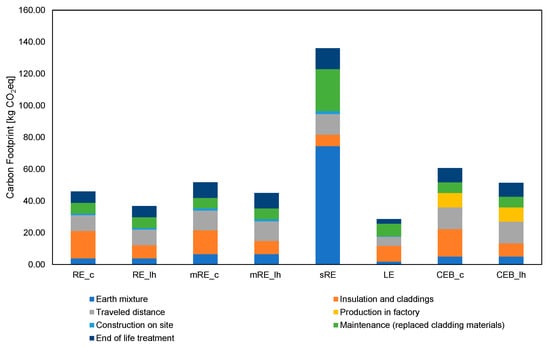
Figure 7.
Input contributions to carbon footprint for each analyzed raw earth wall system.
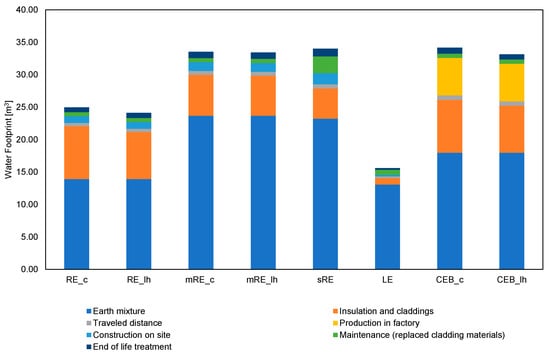
Figure 8.
Input contributions to water footprint for each analyzed raw earth wall system.
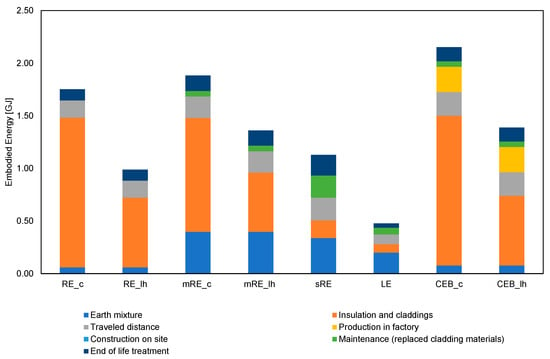
Figure 9.
Input contributions to embodied energy for each analyzed raw earth wall system.
4.1. Influence of the Raw Earth Mixture Composition
With reference to the raw earth mixture preparation phase, it is evident that fiber stabilization of raw earth mixes (used in mRE and LE solutions), namely, with fibers of natural origin such as straw, is able to reduce CF and EE impacts. The same observation can be performed for all the solutions that do not use chemical stabilizers (such as RE and CEB).
In the case of sRE, where cement is used as stabilizer, the earth mixture preparation phase has a major impact, which profoundly influences the total carbon footprint.
To better understand the influence of fiber type on the amount of CO2 emitted and stored, a sensitivity analysis is performed for the mRE solution by varying the natural fibers used in the raw earth mixture (Figure 10). Please note that these impacts are obtained by considering the emission factors of the cultivated fibers, so, in this analysis, they have not been considered as waste or byproducts of another production chain. In particular, the environmental impacts of a rammed earth mixture stabilized with straw fibers are compared with those of rammed earth mix stabilized with flax, juta and hemp fibers.
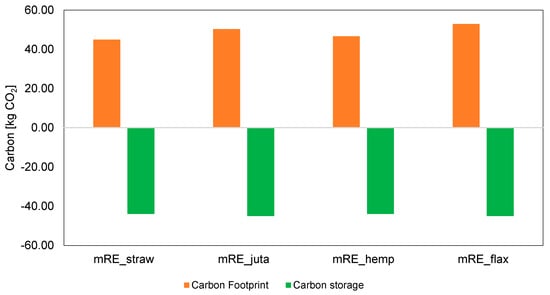
Figure 10.
Carbon footprint and carbon storage of the mRE system for different natural fibers used in the raw earth mixture.
Carbon storage, CF, WF and EE are calculated for all the natural fibers that could be used in the rammed earth mixture of the mRE system, revealing that hemp fibers represent a valuable alternative to straw fibers for the stabilization of rammed earth mixtures from a life cycle perspective.
In this investigation, flax and juta fibers do not seem to be the most appropriate to stabilize the raw earth mixtures given the fact that their water footprint is almost three times the ones of hemp and straw fibers. Please note that the sensitivity analysis reported in Figure 10 only shows values for the mRE solution using the lime hemp insulation (mRE_lh), as it is the one with the lowest environmental impact. It is then remarkable that, in the mRE solutions using hemp, juta and straw fibers, the carbon footprint is almost compensated by the carbon storage.
The graph on water footprint comparison in Figure 8, reveals interesting insights regarding the influence of raw earth techniques in water usage. As is well known, the light earth technique (LE) uses clay in a liquid state, while rammed earth (RE, mRE and sRE solutions) and compressed earth blocks (CEB) activate clays by reaching a moist state of the raw earth mixture. Thus, it could seem obvious that LE technique uses more water compared to moist-state earth techniques. Indeed, this is not correct and it is easily noticeable in Figure 8: the LE system, due to the presence of a higher amount of straw, uses less earth and, consequently, less water per m2, so the WF of LE is the lowest between all the examined solutions. Please note that WF is higher both for the mRE and sRE solutions: this is due to the higher amount of water that must be used to properly homogenize fibers in the mRE raw earth mixture and to properly hydrate cement in the sRE solution.
4.2. Influence of Insulation and Claddings
Influence of insulation type. It is remarkable that a large part of the environmental impact (CF, WF, EE) is attributable to the insulation system. Lime hemp and cork insulations have similar thermal performances but different environmental impacts. Based on our data, the carbon footprint and the embodied energy of the used lime hemp insulation are lower compared to those of cork insulation, although the former requires a thicker layer of insulation. On the contrary, the water footprint of the lime hemp insulation is higher compared to the cork ones. In the case of LE, the earth mixture includes straw, which has a strong insulating power and a low environmental impact, so that a thermal insulating layer is not necessary. In this scenario, the impacts caused by the insulation layer are canceled, while those caused by the cladding layer persist.
Influence of cladding system. The environmental impacts (CF, WF and EE) are highly influenced by the cladding system and, in particular, by the lime plaster exterior layer, which we included in all the analyzed solutions (except for sRE). A lime plaster is needed if the insulation is placed on the outer side of the wall, in order to protect the thermal insulating panel. Lime-based plasters can also ensure greater durability of the outer surfaces compared to exposed earthen surfaces, even if they are subjected to prolonged exposure to the action of water. Opting for an exposed earth surface on the outdoor and an insulation layer on the inside could help to reduce the carbon footprint, but would have negative drawbacks on the durability and would reduce the thermal inertia of the envelope.
4.3. Influence of Transportation Issues, Production and Construction Process
Influence of transportation issues. In general, the environmental impacts are rather modest for all the analyzed earth-based construction systems. This is why transportation, despite not spanning significant distances, has an impact on the overall balance of emissions. CEB solutions are those with the highest environmental impacts in the traveled distance phase, which is a direct consequence of the prefabrication process that they endure. Also, the sRE and the mRE solutions have high environmental impact values in the transportation phase, given by the fact that the volume of material moved is higher.
Influence of production and construction process. Looking at Figure 7, Figure 8 and Figure 9, we can observe that the prefabricated solutions (CEB_c and CEB_lh) have higher environmental impacts compared to those built on site. Indeed, CEBs endure a prefabrication phase in the factory, which contributes to the overall carbon footprint. The impacts connected to the construction process are minimal, given the fact that the technologies built on site (RE, mRE, sRE and LE) and prefabricated ones (CEB) can be laid manually or by minimizing the use of mechanical equipment. Please note that the impacts related to the construction process of RE, mRE, sRE and LE solutions are less than one-third of those related to the production process of the prefabricated solutions (CEB).
4.4. Maintenance
Maintenance phase refers to the renovation processes of the outer layers of the walls. In particular, for RE, mRE, LE and CEB systems, the outer layer is constituted by a lime plaster, while, for the sRE system, the outer layer is constituted by a part of the rammed earth wall. As previously explained, the renovation process is estimated to be carried out every 20 years. In the case of the RE, mRE, LE and CEB systems, the environmental impacts are strongly related to the thickness of the lime plaster layer, which, compared to earthen plaster, has a heavier weight on all three estimated impact categories. Please note that the maintenance phase impacts of the sRE system are related to the outer layer of rammed earth and, in particular, to the possible substitution of the outer 10 cm portion of the wall. It is evident that the substitution of this layer (constituted by a mixture of raw earth and cement) has a much higher environmental impact than the substitution of the 2.5 cm of lime plaster in the other solutions.
4.5. End of Life
The end of life treatments refer to the environmental impacts associated with demolition/disassembling and loading, as well as transport to the site of end of life treatment (or recycling), such as the landfill/incineration or composting plant or direct reuse in construction. As was previously observed, several materials used in the studied earth wall systems can be directly reused in construction. This is, for instance, the case for the raw earth mixtures in the RE, mRE, LE and CEB systems. On the contrary, the raw earth mixture in the sRE system cannot be entirely recycled []. Indeed, some studies in the literature [] affirm that at least part of the cement-stabilized raw earth mix could be reused. In order to take this possibility into account, we assumed that half of the material could be transported to landfill and the other half could be directly reused in construction. Even so, the environmental impact of the sRE system in the end-of-life phase is higher compared to the other systems, even if the difference is not so marked as could have been expected.
5. Conclusions
This contribution has dealt with the assessment of the environmental performances of earth-based wall systems with similar thermal performance, through a life cycle thinking approach. In particular, a life cycle analysis is carried out both for built-on-site technologies and for prefabricated ones. The studied technologies were unstabilized rammed earth (RE), modular biobased reinforced rammed earth (mRE), stabilized rammed earth (sRE), light earth (LE) and compressed earth blocks (CEB, prefabricated in the factory). In order to improve the thermal performance of these walls, the addition of natural fibers to the raw earth mixtures is contemplated (as in the case of mRE and LE). In general, thin layers of thermal insulation were added to the raw earth walls to comply with Italian Energy standards. Biobased thermal insulations (such as lime hemp or cork insulation panels) have been used in combination with walls where raw earth mixtures were not chemically stabilized. On the contrary, synthetic insulation (EPS or XPS) was coupled to cement-stabilized rammed earth walls. The earth wall systems were compared with a conventional building solution (clay block walls) and between them by considering 1 m2 of wall FU.
Results show that, compared to conventional building technologies, earth wall systems combined with thin layers of thermal insulation have better thermal performances and lower environmental impacts. In particular, light earth wall systems seem to be the most adapt to minimize environmental impacts, even if their dynamic thermal behavior should be improved for intended use in Mediterranean climates. Other wall solutions such as unstabilized rammed earth (RE), modular biobased reinforced rammed earth (mRE), compressed earth blocks and stabilized rammed earth (sRE) solutions seem to be more suitable for the investigated climate but have higher environmental impacts. It is worth noticing that the mRE and sRE wall solutions are the sole construction systems with reinforcing elements (counted in the LCA), which could enable their use in seismic-prone areas. The effect of reinforcing elements and structures in the other wall systems should be addressed in future works.
The composition of the raw earth mixture has a relevant effect on carbon footprint CF and water footprint WF. Indeed, sRE systems, which use cement-stabilized raw earth mixtures, have the highest CF and WF due to the use of cement. Use of natural fibers in the earth mixture has the beneficial effect of storing CO2 inside the material, so as to fully (or partially) compensate the carbon footprint of the entire wall system (such as in mRE and LE solutions). An even higher beneficial effect could be obtained by using natural by-products, a hypothesis which should be taken into account in future studies. In this analysis, the lowest environmental impacts were found for straw and hemp fibers.
A direct consequence of not using cement stabilization in raw earth mixtures is the need to protect the outdoor layer of walls by using a cladding system, for instance, a lime plaster. Taking this cladding layer into account is a peculiarity of the proposed analysis. It was found that the environmental impacts of cladding and insulation elements can be quite relevant, especially if plasters are to be substituted every 20 years (a higher maintenance rate is to be foreseen for raw earth-based technologies). Concerning the thermal insulation, lime hemp panels have lower environmental impact compared to cork panels, but also lower thermal performance.
Regarding production and construction phases, prefabricated earth technologies such as compressed earth blocks (CEB) have a production phase that generates more than three times the impact of the construction phase of built-on-site raw earth technologies.
Lastly, with regard to the end-of-life of earth-based wall systems, it is confirmed that appropriate choices can be made to contain the environmental impacts due to the disposal of earth mixtures in landfill by avoiding the use of chemical stabilization. This will allow the raw earth mixtures to have a new life in which they could either be directly reused in construction or reintegrated into the natural environment.
As demonstrated, earth-based technologies can potentially address the ambitious energy targets of most recent regulations. Furthermore, compared to mainstream and highly processed materials utilized in modern buildings, earth-based materials provide an environmentally friendly substitute. Although it is still a relatively unexplored field, rules and policies that promote low environmental impact of the built environment together with conformity to other energy, safety, and comfort criteria should focus more and more on modern earth construction and production.
Author Contributions
Conceptualization, G.G., L.D., R.M.P. and R.C.; methodology, G.G., L.D., R.M.P. and R.C.; software, R.M.P.; validation, L.D. and R.M.P.; formal analysis, G.G., L.D. and R.M.P.; investigation, G.G., L.D., R.M.P. and R.C.; resources, L.D., R.M.P. and R.C.; data curation, G.G.; writing—original draft preparation, G.G., L.D., R.M.P. and R.C.; writing—review and editing, G.G., L.D., R.M.P. and R.C.; visualization, G.G. and L.D.; supervision, L.D., R.M.P. and R.C.; project administration, L.D., R.M.P. and R.C.; funding acquisition, L.D., R.M.P. and R.C. All authors have read and agreed to the published version of the manuscript.
Funding
This research received no external funding.
Institutional Review Board Statement
Not applicable.
Informed Consent Statement
Not applicable.
Data Availability Statement
Data are available upon request.
Conflicts of Interest
The authors declare no conflicts of interest.
Nomenclature
| t | Thickness of the layer in meters [m] |
| ttot | Total thickness of the wall assembly in meters [m] |
| λ | Thermal conductivity in [W/mK] |
| cp | Specific heat capacity in [J/kg K] |
| ρ | Dry density in [kg/m3] |
| SM | Surface mass in [kg/m2] |
| U | Thermal transmittance in [W/m2K] |
| Yie | Periodic thermal transmittance in [W/m2K] |
| TL | Time lag in hours [h] |
| DF | Decrement factor [-] |
| CF | Carbon footprint, expressed in [kg CO2 eq] |
| WF | Water footprint, expressed in [m3] |
| CS | Carbon storage, expressed in [kg CO2 ] |
| EE | Embodied energy, expressed in [GJ] |
| LCA | Life cycle assessment |
| FU | Functional unit |
| GWP | Global Warming Potential |
| RE | Rammed earth (construction technology) |
| URE | Unstabilized rammed earth (type of raw earth mix) |
| FSRE | Fiber-stabilized rammed earth (type of raw earth mix) |
| CEB | Compressed earth block (construction technology) |
| LSC | Light straw clay (construction technology) |
| LE | Light earth (construction technology) |
| mRE | Modular biobased reinforced rammed earth (construction technology) |
| sRE | Core-insulated cement-stabilized rammed earth (construction technology) |
| c | Cork insulation |
| lh | Lime hemp insulation |
| PU | Polyurethane insulation |
| XPS | Extruded polystyrene insulation |
| EPS | Expanded polystyrene insulation |
References
- Minke, G. Building with Earth: Design and Technology of a Sustainable Architecture; Birkhäuser: Berlin, Germany, 2006. [Google Scholar]
- Dobson, S. Rammed Earth in the Modern World. In Rammed Earth Construction: Cutting-Edge Research on Traditional and Modern Rammed Earth; Ciancio, D., Beckett, C., Eds.; CRC Press: Boca Raton, FL, USA; Taylor & Francis Group: London, UK, 2015; pp. 3–10. ISBN 978-1-315-69294-4. [Google Scholar]
- Morel, J.C.; Charef, R.; Hamard, E.; Fabbri, A.; Beckett, C.; Bui, Q.B. Earth as construction material in the circular economy context: Practitioner perspectives on barriers to overcome. Philos. Trans. R. Soc. B 2021, 376, 20200182. [Google Scholar] [CrossRef]
- Bestraten, S.; Hormías, E.; Altemir, A. Construcción con tierra en el siglo XXI, Earthen construction in the 21rst century. Inf. Constr. 2011, 63, 5–20, julio-septiembre 2011. [Google Scholar] [CrossRef]
- Jaquin, P.A.; Augarde, C.E.; Gerrard, C.M. Chronological description of the spatial development of rammed Earth techniques. Int. J. Archit. Herit. 2008, 2, 377–400. [Google Scholar] [CrossRef]
- Niroumand, H.; Zain, M.F.M.; Jamil, M. Various Types of Earth Buildings. Procedia Soc. Behav. Sci. 2013, 89, 226–230. [Google Scholar] [CrossRef]
- Smith, P.; Keesstra, S.D.; Silver, W.L.; Adhya, T.K.; De Deyn, G.B.; Carvalheiro, L.G.; Giltrap, D.L.; Renforth, P.; Cheng, K.; Sarkar, B.; et al. Soil derived Nature’s Contributions to People and their contribution to the UN Sustainable Development Goals. Philos. Trans. R. Soc. B 2021, 376, 20200185. [Google Scholar] [CrossRef]
- Fabbri, A.; Morel, J.C.; Aubert, J.E.; Bui, Q.B.; Gallipoli, D.; Venkatarama Reddy, B.V. Testing and Characterisation of Earth-based Building Materials and Elements. In State-of-the-Art Report of the RILEM TC 274-TCE; Springer: Berlin/Heidelberg, Germany, 2022. [Google Scholar] [CrossRef]
- Schweiker, M.; Endres, E.; Gosslar, J.; Hack, N.; Hildebrand, L.; Creutz, M.; Klinge, A.; Kloft, H.; Knaack, U.; Mehnert, J.; et al. Ten questions concerning the potential of digital production and new technologies for contemporary earthen construction. Build. Environ. 2021, 206, 108240. [Google Scholar] [CrossRef]
- Van der Linden, J.; Janssens, B.; Knapen, E. Potential of contemporary earth architecture for low impact building in Belgium. IOP Conf. Ser. Earth Environ. Sci. 2019, 323, 012018. [Google Scholar] [CrossRef]
- Adegun, O.B.; Adedeji, Y.M.D. Review of economic and environmental benefits of earthen materials for housing in Africa. Front. Archit. Res. 2017, 6, 519–528. [Google Scholar] [CrossRef]
- Marques, B.; Varum, H.; Coravacho, H.; Correia Guedes, M.; Baptista, L. Using Raw Earth Construction Systems on Contemporary Buildings: Reflections on Sustainability and Thermal Efficiency. Renew. Energy Environ. Sustain. 2021, 6, 46. [Google Scholar] [CrossRef]
- Giuffrida, G.; Detommaso, M.; Nocera, F.; Caponetto, R. Design optimisation strategies for solid rammed earth walls in Mediterranean climates. Energies 2021, 14, 325. [Google Scholar] [CrossRef]
- McGregor, F.; Heath, A.; Maskell, D.; Fabbri, A.; Morel, J.C. A review on the buffering capacity of earth building materials. Proc. Inst. Civ. Eng. Constr. Mater. 2016, 169, 241–251. [Google Scholar] [CrossRef]
- Darling, E.K.; Cros, C.J.; Wargocki, P.; Kolarik, J.; Morrison, G.C.; Corsi, R.L. Impacts of a clay plaster on indoor air quality assessed using chemical and sensory measurements. Build. Environ. 2012, 57, 370–376. [Google Scholar] [CrossRef]
- Ben-Alon, L.; Rempel, A.R. Thermal comfort and passive survivability in earthen buildings. Build. Environ. 2023, 238, 110339. [Google Scholar] [CrossRef]
- Costa-Carrapiço, I.; Gonzalez, J.N.; Raslan, R.; Sanchez-Guevara, C.; Redondas Marrero, M.D. Understanding thermal comfort in vernacular dwellings in Alentejo, Portugal: A mixed-methods adaptive comfort approach. Build. Environ. 2022, 217, 109084. [Google Scholar] [CrossRef]
- Hall, M.R.; Casey, S. Hygrothermal behaviour and occupant comfort in modern earth buildings. In Modern Earth Buildings, Materials, Engineering, Constructions and Applications; Woodhead Publishing Series in Energy; Woodhead Publishing: Sawston, UK, 2012; pp. 17–40. [Google Scholar] [CrossRef]
- Charai, M.; Mezrhab, A.; Moga, L. A structural wall incorporating biosourced earth for summer thermal comfort improvement: Hygrothermal characterization and building simulation using calibrated PMV-PPD model. Build. Environ. 2022, 212, 108842. [Google Scholar] [CrossRef]
- Brambilla, A.; Jusselme, T. Preventing overheating in offices through thermal inertial properties of compressed earth bricks: A study on a real scale prototype. Energy Build. 2017, 156, 281–292. [Google Scholar] [CrossRef]
- Pacheco-Torgal, F.; Jalali, S. Earth construction: Lessons from the past for future eco-efficient construction. Construct. Build. Mater. 2012, 29, 512–519. [Google Scholar] [CrossRef]
- Liuzzi, S.; Hall, M.R.; Stefanizzi, P.; Casey, S.P. Hygrothermal behaviour and relative humidity buffering of unfired and hydrated lime-stabilised clay composites in a Mediterranean climate. Build. Environ. 2012, 61, 82–92. [Google Scholar] [CrossRef]
- Losini, A.E.; Woloszyn, M.; Chitimbo, T.; Pelé-Peltier, A.; Ouertani, S.; Rémond, R.; Doya, M.; Gaillard, D.; Force, M.S.; Outin, J.; et al. Extended hygrothermal characterization of unstabilized rammed earth for modern construction. Constr. Build. Mater. 2023, 409, 133904. [Google Scholar] [CrossRef]
- Akom, J.B.; Sadick, A.M.; Issa, M.H.; Rashwan, S.; Duhoux, M. The indoor environmental quality performance of green low-income single-family housing. J. Green. Build. 2018, 13, 98–120. [Google Scholar] [CrossRef]
- Mateus, R.; Fernandes, J.E.P.; Teixeira, E.R. Environmental Life Cycle Analysis of Earthen Building Materials. In Encyclopedia of Renewable and Sustainable Materials; Elsevier BV: Amsterdam, The Netherlands, 2020; pp. 63–68. [Google Scholar] [CrossRef]
- Morel, J.C.; Charef, R. What are the barriers affecting the use of earth as a modern construction material in the context of circular economy? IOP Conf. Ser. Earth Environ. Sci. 2019, 225, 012053. [Google Scholar] [CrossRef]
- Schroder, L.; Ogletree, V. Adobe Homes for All Climates: Simple, Affordable, and Earthquake-Resistant Natural Building Techniques; Chelsea Green Publishing: Chelsea, VT, USA, 2010. [Google Scholar]
- Dabaieh, M. More than Vernacular: Vernacular Architecture between Past Tradition and Future Vision; Lund University (Media-Tryck): Lund, Sweden, 2015. [Google Scholar]
- Leitào, D.; Barbosa, J.; Soares, E.; Miranda, T.; Cristelo, N.; Briga-Sá, A. Thermal performance assessment of masonry made of ICEB’s stabilised with alkaliactivated fly ash. Energy Build. 2017, 139, 44–52. [Google Scholar] [CrossRef]
- Hamard, E.; Cazacliu, B.; Razakamanantsoa, A.; Morel, J.-C. Cob, a vernacular earth construction process in the context of modern sustainable building. Build. Environ. 2016, 106, 103–119. [Google Scholar] [CrossRef]
- Cabeza, L.F.; Barreneche, C.; Miró, L.; Morera, J.M.; Bartolí, E.; Fernandez, A.I. Low carbon and low embodied energy materials in buildings: A review. Renew. Sustain. Energy Rev. 2013, 23, 536–542. [Google Scholar] [CrossRef]
- Caponetto, R.; Di Mari, C.; Giuffrida, G.; Nocera, F. Analysis of the environmental, economic, thermal and energy performances of green building technologies. Renew. Energy Power Qual. J. 2022. [Google Scholar] [CrossRef]
- Shukla, A.; Tiwari, G.N.; Sodha, M.S. Embodied energy analysis of adobe house. Renew. Energy 2009, 34, 755–761. [Google Scholar] [CrossRef]
- Reddy, B.V.V.; Kumar, P.P. Embodied energy in cement stabilised rammed earth walls. Energy Build. 2010, 42, 380–385. [Google Scholar] [CrossRef]
- Melià, P.; Ruggieri, G.; Sabbadini, S.; Dotelli, G. Environmental impacts of natural and conventional building materials: A case study on earth plasters. J. Clean. Prod. 2014, 80, 179–186. [Google Scholar] [CrossRef]
- Suprahman, F.H.; Nurafifah, N. Analysis of Embodied Energy in the Construction of The Prototype of Rammed Earth Wall. J. Archit. Res. Des. Stud. 2022, 6, 52–60. [Google Scholar] [CrossRef]
- Serrano, S.; Barreneche, C.; Rincon, L.; Boer, D.; Cabeza, L.F. Optimization of three new compositions of stabilized rammed earth incorporating PCM: Thermal properties characterization and LCA. Constr. Build. Mater. 2013, 47, 872–878. [Google Scholar] [CrossRef]
- Arrigoni, A.; Beckett, C.; Ciancio, D.; Dotelli, G. Life cycle analysis of environmental impact vs. durability of stabilised rammed earth. Constr. Build. Mater. 2017, 142, 128–136. [Google Scholar] [CrossRef]
- Christoforou, E.; Kylili, A.; Fokaides, P. Cradle to site LCA of adobe bricks. J. Clean. Prod. 2016, 112, 443–452. [Google Scholar] [CrossRef]
- Nanz, L.; Rauch, M.; Honermann, T.; Auer, T. Impacts on the Embodied Energy of Rammed Earth Facades During Production and Construction Stages. J. Facade Des. Eng. 2019, 7, 75–88. [Google Scholar] [CrossRef]
- Arduin, D.; Rosse Caldas, L.; de Lima Moura Paiva, R.; Rocha, F. Life Cycle Assessment (LCA) in Earth Construction: A Systematic Literature Review Considering Five Construction Techniques. Sustainability 2022, 14, 13228. [Google Scholar] [CrossRef]
- Narayanaswamy, A.H.; Walker, P.; Reddy, B.V.V.; Heath, A.; Maskell, D. Mechanical and thermal properties, and comparative life-cycle impacts of stabilised earth building products. Constr. Build. Mater. 2020, 243, 118096. [Google Scholar] [CrossRef]
- Ben-Alon, L.; Loftness, V.V.; Harries, K.A.; Cochran Hameen, E. Life cycle assessment (LCA) of natural vs conventional building assemblies. Renew. Sust. Energy Rev. 2021, 144, 110951. [Google Scholar] [CrossRef]
- Meek, A.H.; Elchalakani, M.; Beckett, C.T.S.; Grant, T. Alternative stabilised rammed earth materials incorporating recycled waste and industrial by-products: Life cycle assessment. Constr. Build. Mater. 2021, 267, 120997. [Google Scholar] [CrossRef]
- Fernandes, J.; Peixoto, M.; Mateus, R.; Gervàsio, H. Life cycle analysis of environmental impacts of earthen materials in the Portuguese context: Rammed earth and compressed earth blocks. J. Clean. Prod. 2019, 241, 118286. [Google Scholar] [CrossRef]
- Giuffrida, G.; Costanzo, V.; Nocera, F.; Cuomo, M.; Caponetto, R. Natural and Recycled Stabilizers for Rammed Earth Material Optimization. In Sustainability in Energy and Buildings; Littlewood, J., Howlett, R.J., Jain, L.C., Eds.; 2022, SEB 2022. Smart Innovation, Systems and Technologies; Springer: Singapore, 2023; Volume 336, pp. 164–174. [Google Scholar] [CrossRef]
- Losini, A.E.; Grillet, A.C.; Bellotto, M.; Woloszyn, M.; Dotelli, G. Natural additives and biopolymers for raw earth construction stabilization—A review. Constr. Build. Mater. 2021, 304, 124507. [Google Scholar] [CrossRef]
- Dipasquale, L.; Pulselli, R.M. Assessing environmental performance and climate change mitigation effects of biobased materials for building retrofitting. In Mediterranean Architecture and the Green-Digital Transition; Sayigh, A., Ed.; Springer Nature: Cham, Switzerland, 2022. [Google Scholar] [CrossRef]
- Decreto del Ministero dello Sviluppo Economico 26/06/2015. Applicazione delle Metodologie di Calcolo delle Prestazioni Energetiche e Definizione delle Prescrizioni e dei Requisiti Minimi Degli Edifici. Available online: https://www.gazzettaufficiale.it/eli/id/2015/07/15/15A05198/sg (accessed on 30 November 2023).
- Houben, H.; Guillaud, H. CRATerre: Traité de Construction en Terre; Éditions Parenthèses: Marseille, France, 2006. [Google Scholar]
- Giuffrida, G.; Caponetto, R.; Nocera, F.; Cuomo, M. Prototyping of a novel rammed earth technology. Sustainability 2021, 13, 11948. [Google Scholar] [CrossRef]
- Dong, X. Thermal and Structural Performances of Insulated Cavity Rammed Earth Wall Houses. Ph.D. Thesis, University of Adelaide, Adelaide, Australia, 2015. Available online: https://digital.library.adelaide.edu.au/bitstream (accessed on 18 December 2023).
- Allison, D.; Hall, M. Hygrotermal analysis of a stabilised rammed earth test building in the UK. Energy Build. 2010, 42, 845–852. [Google Scholar] [CrossRef]
- Krayenhoff, M. Formwork and Method for Constructing Rammed Earth Walls. U.S. 8,375,669 B2, 19 February 2013. [Google Scholar]
- Krayenhoff, M. Rammed Earth Thermodynamics. In Rammed Earth Construction; Ciancio, D., Beckett, C.T.S., Eds.; Taylor & Francis Group: London, UK, 2015. [Google Scholar]
- Volhard, F. Light Earth Building, A Handbook for Building with Wood and Earth; Birkhauser: Basel, Switzerland, 2016. [Google Scholar]
- UNI 10351:2021; Materiali da Costruzione-Proprietà Termoigrometriche-Procedura per la Scelta dei Valori di Progetto. UNI Italian Standards Body: Milan, Italy, 2021.
- Williams, J.; Lawrence, M.; Walker, P. The influence of the casting process on the internal structure and physical properties of hemp-lime. Mater. Struct. 2017, 50, 108. [Google Scholar] [CrossRef] [PubMed]
- Caponetto, R.; Cuomo, M.; Detommaso, M.; Giuffrida, G.; Presti, A.L.; Nocera, F. Performance Assessment of Giant Reed-Based Building Components. Sustainability 2023, 15, 2114. [Google Scholar] [CrossRef]
- Labat, M.; Magniont, C.; Oudhof, N.; Aubert, J.E. From the experimental characterization of the hygrothermal properties of straw-clay mixtures to the numerical assessment of their buffering potential. Build. Environ. 2016, 97, 69–81. [Google Scholar] [CrossRef]
- Hall, M.; Allinson, D. Assessing the effects of soil grading on the moisture content-dependent thermal conductivity of stabilised rammed earth materials. Appl. Therm. Eng. 2009, 29, 740–774. [Google Scholar] [CrossRef]
- Fiche Technique Bloc BTC Cycle Terre. Available online: https://www.cycle-terre.eu/wp-content/uploads/2021/04/FT_BTC_201108.pdf (accessed on 30 November 2023).
- UNI EN ISO 6946:2018; Componenti ed Elementi per Edilizia—Resistenza Termica e Trasmittanza Termica—Metodo di Calcolo. UNI Italian Standards Body: Milan, Italy, 2018.
- UNI EN ISO 13786:2008; Prestazione Termica dei Componenti per Edilizia—Caratteristiche Termiche Dinamiche—Metodo di Calcolo. UNI Italian Standards Body: Milan, Italy, 2008.
- Standard ISO 14040; Environmental Management. Life Cycle Assessment: Principles and Framework. International Standard Organization: Geneva, Switzerland, 2006.
- UNI EN ISO 14044; Gestione Ambientale-Valutazione del Ciclo di Vita-Requisiti e Linee Guida. International Standard Organization: Geneva, Switzerland, 2020.
- EPD Wienerberger. Available online: https://www.wieneberger.it/italy/internal (accessed on 18 December 2023).
- Van Damme, H.; Houben, H. Earth concrete. Stabilization revisited. Cem. Concr. Res. 2018, 114, 90–102. [Google Scholar] [CrossRef]
Disclaimer/Publisher’s Note: The statements, opinions and data contained in all publications are solely those of the individual author(s) and contributor(s) and not of MDPI and/or the editor(s). MDPI and/or the editor(s) disclaim responsibility for any injury to people or property resulting from any ideas, methods, instructions or products referred to in the content. |
© 2024 by the authors. Licensee MDPI, Basel, Switzerland. This article is an open access article distributed under the terms and conditions of the Creative Commons Attribution (CC BY) license (https://creativecommons.org/licenses/by/4.0/).